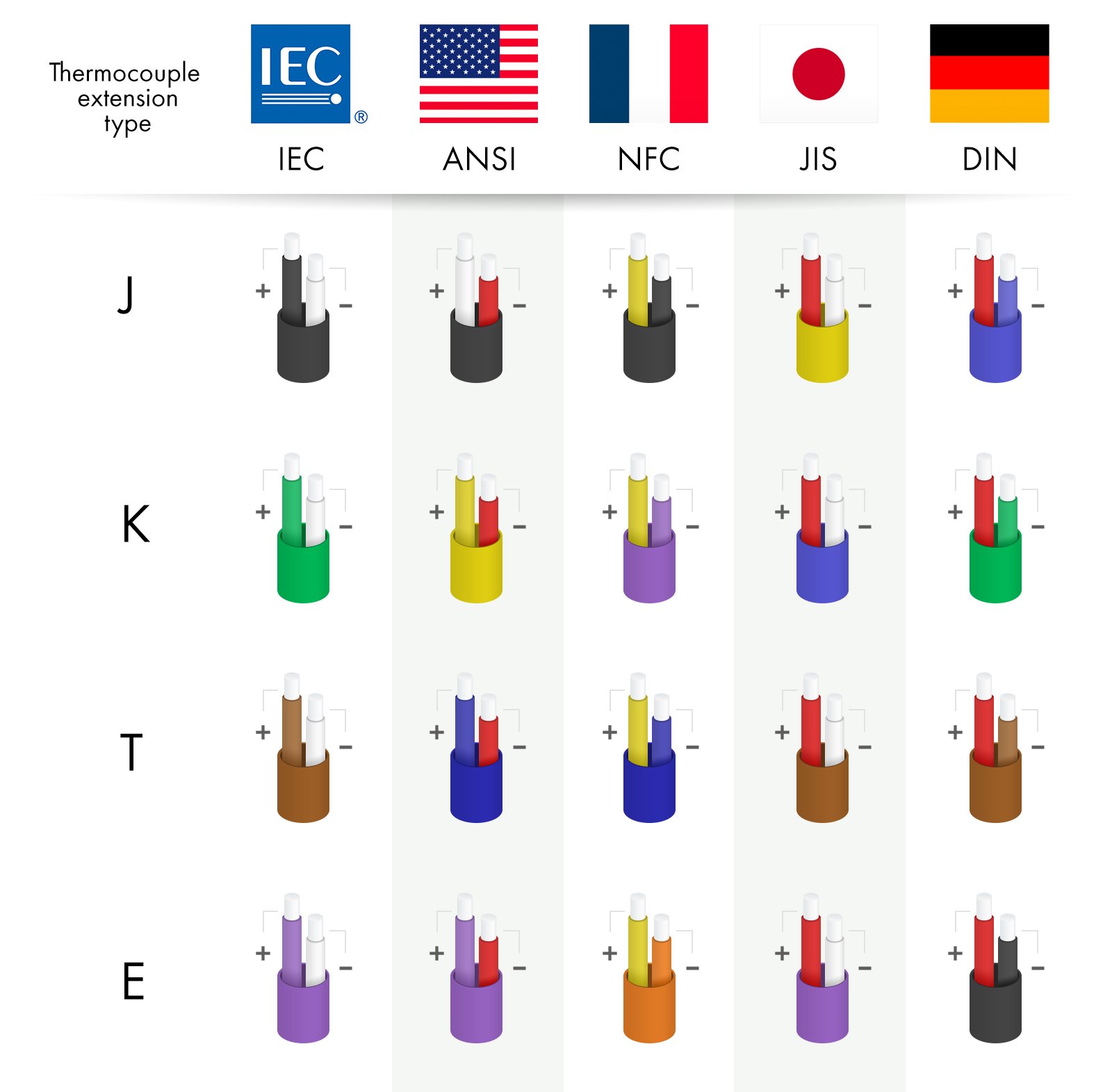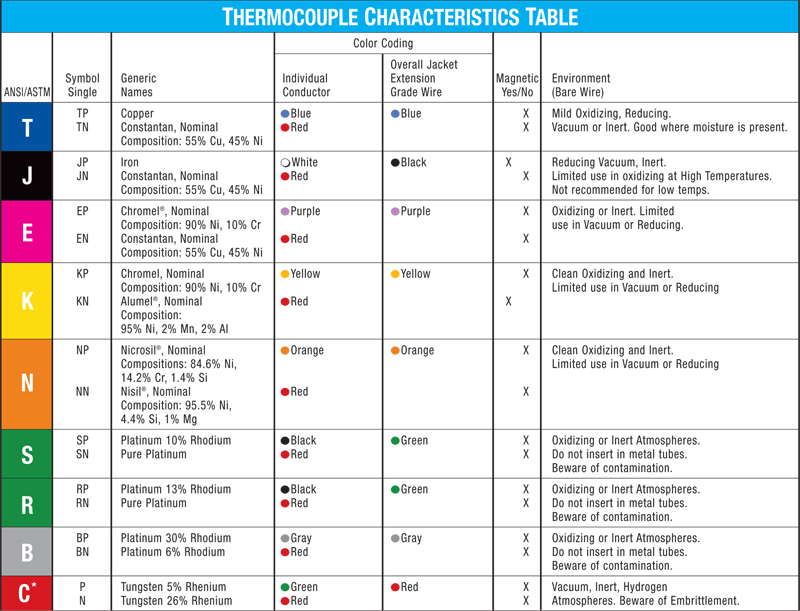How to Determine Which Thermocouple Type to Use
The temperature sensor range that each sensor type can. Thermocouples usually come in a 2-wire construction.
Thermocouple Working Types E J K T S R Grounding Thermopile Advantages
Constantan Copper Iron J1 TTTC J3 J2 VMEAS.
. Sometimes they employ a 3-wire construction if a ground or. If the sensor has two lead wires measure the. Unlike type J or K materials which would be at their melting points at this high of a temperature.
To determine whether a sensor may be a thermocouple or an RTD is to measure the resistance using a Volt Ohm Meter. In more precise temperature measurement a bare-wire thermocouple without protective sleeve is used but the thermocouple is easily damaged and should be corrected and replaced in time. A short-cut to identifying your temperature sensor is to give us a call on 01246 261 999.
There are three different testing methods that you can use to test your thermocouple. He also explains a case study in which the customer did not know which type of thermocouple he had. Therefore by measuring VMEAS and Tref and knowing the voltage-to-temperature relationship of the thermocouple you can determine the temperature of the thermocouple.
NIST publishes tables of polynomial coefficients for each type of thermocouple. Select the thermocouple type on the menu of the calibrator Fluke 5522a and indicator Fluke 754. There are many types of thermocouples each with its own unique characteristics.
Measure the VD millivoltage as shown above. Calculate the average sensitivity μVC of a type K thermocouple in the temperature range 0 C to 100 C. The change in emf developed by a type K thermocouple from 0 C to 100 C is 4096 μV.
Thermocouple calibrators are generally available in a basic model which will support Types J Type K Type T and Type E thermocouple probes which are the four most popular thermocouple types and a higher priced model that will support 14 or more thermocouple types. Looking at the chart Kyle is able to show you how to determine your type of thermocouple. We Carry a Large Selection of Thermocouple Assemblies.
With that in mind lets discuss a few common thermocouple types and when the most common thermocouple type might not be the best choice. When choosing a thermocouple you must compare these characteristics with your testing requirements. In these tables are lists of coefficients order the number of terms in the polynomial valid temperature ranges for each list of coefficients and error range.
Type K thermocouples are often selected. Therefore formula 2 is rewritten as follows. The choice of using atmosphere S type B type K thermocouple right in strong oxidation and the weak recovery in atmosphere J type and T type thermocouple is suitable in weak oxidizing atmosphere and recovery if use air tightness match good maintenance tube the atmosphere of the request is not too strict.
If you are a heat treater or measuring high temperatures you will need the model with. From Above Table. However if your thermocouple probe will be exposed to extreme temperatures a type N thermocouple is more stable in high temperatures and a type T thermocouple is best for extremely low temperatures.
Common Thermocouple Types Thermocouple Type Lead Metal. Table 1 lists several common thermocouple types and their characteristics. T temperature C n order of polynomial.
If the sensor has two lead wires measure the resistance between the two leads. Ad Fast lead times. They have very low resistance compared to RTDs and thermistors Depending on the thermocouples type a thermocouples wires may be magnetic.
Turn on the Fluke 5522a calibrator and connect the thermocouple as shown in the Figure. The three main tests are closed-circuit testing open circuit testing and resistance testing. Ad We Stock a Large Selection of Thermocouple Assemblies.
How to identify a thermocouple. To visualize this phenomenon consider the alumel wire in Figure 1 below. To put that in perspective steel and iron melt at around 1400ºC and 1500ºC respectfully so this type of thermocouple would be an ideal fit for specialized industrial use.
Selection of Thermocouple Type Metals combinations used to form thermocouple pairs vary greatly in service temperature and initial accuracy. For low temperature high accuracy re-quirements a type T thermocouple might be used whereas in high tem-perature metals processing and heat treatment a platinum metals type S might be used. This may not be straightforward due to Jargon.
They are all useful but the best one is probably the closed circuit. Different colors for insulation and lead wires also indicate the thermocouple grade and extension grade. Thats because it tests if the thermocouple is able to properly handle the load it is designated.
Always examine thermocouple manufacturers specifications for conformity to standards specified temperature ranges and interchangeability. These are the basics of its application. A type K thermocouple offers a wide temperature range and is one of the most often used thermocouples.
The type B thermocouple can measure from 200ºC all the way up to 1700ºC. The Seebeck effect is a phenomenon where a temperature gradient along a material produces a voltage going down from hotter region to colder region. Reproducibility and interchangeability between brands of thermocouple should be examined.
To see the color code chart that Kyle mentions in the video click here. You can easily identify a thermocouple type by the colors of its wire insul. Voltage that the thermocouple type undergoing testing generates this voltage can be renamed VTC.
To understand how thermocouples work first we must look at the Seebeck effect. Go to the table for the thermocouple being used and look up the millivoltage produced at that temperature. Thermocouple leads and connectors are standardized with color plugs and jacks indicating the type of thermocouple.
In use materials with good thermal conductivity are usually used and protective sleeves with thin tube walls and small inner diameters are used. A n thermocouple-type-dependent polynomial coefficients. Determine the range of the thermocouple wire or the user range an example is from 250 to 700 deg Celsius choose at least 5 test point.
Measure the actual temperature of the reference junction with a thermometer. Type K Type J and Type T. The average sensitivity is therefore 4096100 4096 μVC.
Add that millivoltage to the millivoltage measured as VD to get a.

How To Identify The Type Of Thermocouple

No comments for "How to Determine Which Thermocouple Type to Use"
Post a Comment